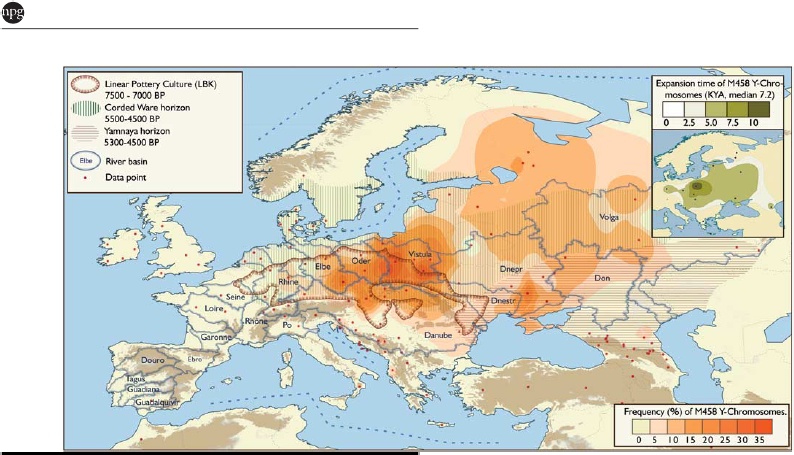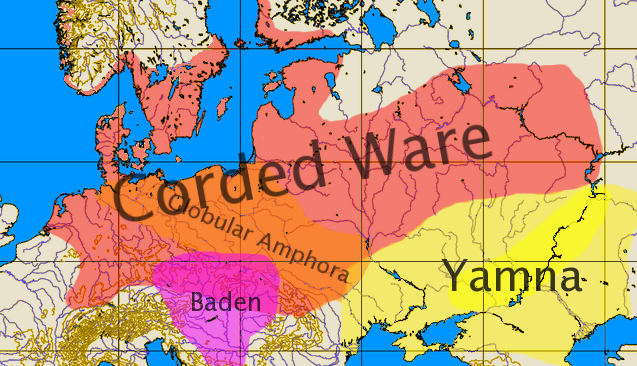Taranis
Elite member
I know that R1a is pretty scarce in Western Europe, but I thought it might be worth asking this: what is the origin of R1a in Western European countries? How/when was it accumulated to the levels we witness today?
Follow along with the video below to see how to install our site as a web app on your home screen.

Note: This feature currently requires accessing the site using the built-in Safari browser.
R1a in Western Europe is probably in great part the result of the Germanic invasions (Vikings included). Some of it could have been there from the Indo-European expansion that brought R1b1b2 to Western Europe.
R1b1b2 was NOT braught to Western Europe during the IE expansion because R1b1b2 is on Western Europe since the neolithic and may be before ...
R1b1b2 was NOT braught to Western Europe during the IE expansion because R1b1b2 is on Western Europe since the neolithic and may be before ...
Impossible, the latest study on the structure of R1b clearly
R1b1b2a1 is about 6000 years old
genetically, I would put apart Germans and Vikings....R1a in Western Europe is probably in great part the result of the Germanic invasions (Vikings included). Some of it could have been there from the Indo-European expansion that brought R1b1b2 to Western Europe.
genetically, I would put apart Germans and Vikings....
at least because Scandinavians and Vikings had abundance of R1a for a long time, while Germans of today mostly acquired it from Slavs in east Germany...

You are right saying that Scandinavians should be a separate category from other Germanic peoples, but I disagree that German R1a is of Slavic origin. Ancient DNA tests have proven that R1a was already in Germany during the Corded Ware period, at least 4500 years ago, and STR markers show a continuity with modern German R1a. The Slavs only came to Central Europe in the late Antiquity, less than 1500 years ago.
Besides, most of the Slavic R1a falls into the R1a1a1g (M458) subclade, which is present at low frequencies in Austria, Bavaria and Thuringia (according to the map below) and almost inexistent in the rest of Germany, Scandinavia and Western Europe. Judge by yourself (this map is from the R1a study by Underhill 2009).

The reason why I would place Scandinavians in a separate category from other Germanic people is because of their higher degree of Siberian admixture (hg N and Q) and consequently the higher incidence of Mongoloid features.
On another topic, I've sent you a couple of private emails requesting help re H5 Mtdna. Did you receive them? I'd appreciate your kind advice if possible, please.
Sorry, I don't have time to reply to emails (nor to all forum posts for that matter). If you asked the question on the forum and I didn't reply it means I don't have much to say on the topic, or it requires too much research.

that is debatable...You are right saying that Scandinavians should be a separate category from other Germanic peoples, but I disagree that German R1a is of Slavic origin.
really?Ancient DNA tests have proven that R1a was already in Germany during the Corded Ware period, at least 4500 years ago, and STR markers show a continuity with modern German R1a.
actually you are wrong there... we can discuss about when IE Slavic languages and cultures came to Europe....but table above gives a clue that genetical forfathers of most Slavs of today are in Europe for long time...The Slavs only came to Central Europe in the late Antiquity, less than 1500 years ago.
ehm, M458 is the name for most European R1a... in fact, besides being overwhelming in slavic lands, it maps better to non-Slavic lands and is probably more frequent in older expansion (not necesserilly corded ware) ...Besides, most of the Slavic R1a falls into the R1a1a1g (M458) subclade, which is present at low frequencies in Austria, Bavaria and Thuringia (according to the map below) and almost inexistent in the rest of Germany, Scandinavia and Western Europe. Judge by yourself (this map is from the R1a study by Underhill 2009).
N R1a1a total R1a1a*(xM458) R1a1a7* ReferenceThe reason why I would place Scandinavians in a separate category from other Germanic people is because of their higher degree of Siberian admixture (hg N and Q) and consequently the higher incidence of Mongoloid features.
Besides, most of the Slavic R1a falls into the R1a1a1g (M458) subclade, which is present at low frequencies in Austria, Bavaria and Thuringia (according to the map below) and almost inexistent in the rest of Germany, Scandinavia and Western Europe.
| Your Halogroup | Tests |
|---|---|
| R1a1a1 | Z93+ M417+ M198+ Z94- Z284- Z283- PK5- P98- M64.2- M56- M458- M434- M157.1- L176.1- L175- L12- |
I hope that you or someone can clear this up.
I am R1a1a1 SNP Z93+, SNPs M417, M198 positive, L2833-, L284-
Full results:
Your Halogroup Tests R1a1a1 Z93+ M417+ M198+ Z94- Z284- Z283- PK5- P98- M64.2- M56- M458- M434- M157.1- L176.1- L175- L12-
According to Lapinski, given that I am Z93+, I am R1a1a1g*, however I am M458-, M417+
I have a long ancestral history in England, documented to the reign of Henry VII, and it is believed to be of Norman origin.
I am , apparently, not of Scandanavian Viking origin, my surname is of French Norman origin.
But the real question is why would L. Lapinski have me at R1a1a1g* as I'm Z93+, but M458-

According to latest draft tree from ISOGG Z93* = R1a1a1h*
http://www.isogg.org/tree/ISOGG_HapgrpR.html
Perhaps he mistyped. Here's a fairly recent version of his R1a tree taken from R1a project site.
http://i1127.photobucket.com/albums/l625/ft-d/R1a-ch.jpg

Interesting trees, thanks for sharing that.
Regarding the original thread topic, it would be interesting to see now the various concentrations of Western European R1a plot:
In my opinion, the only sensible candidates for me for "native" subclades of R1a (that is, not having their in relatively late, historic times, ie. Migration Period, Vikings, etc.) in Western Europe are either R1a1a* and R1a1a1i (R1a-L664). It would be interesting to see where and how R1a from Ireland, Scotland, the Auvergne and Cantabria plot here and if they have any sizable occurence of the above. If not, well, any other subclades Z284, Z280 etc. are certainly from later events (Vikings, Goths, Suebi, Anglo-Saxons, Franks, etc. - depending on the area, some of the French and Iberian R1a may even be Sarmatian in origin, but I expect the latter to be hardly more than noise).
L664 : Found in an Irish member of the Northwestern (DYS388 = 10) branch,
and confirmed in a 1000 Genomes sample. May include much or all of that
branch.
This thread has been viewed 46879 times.
